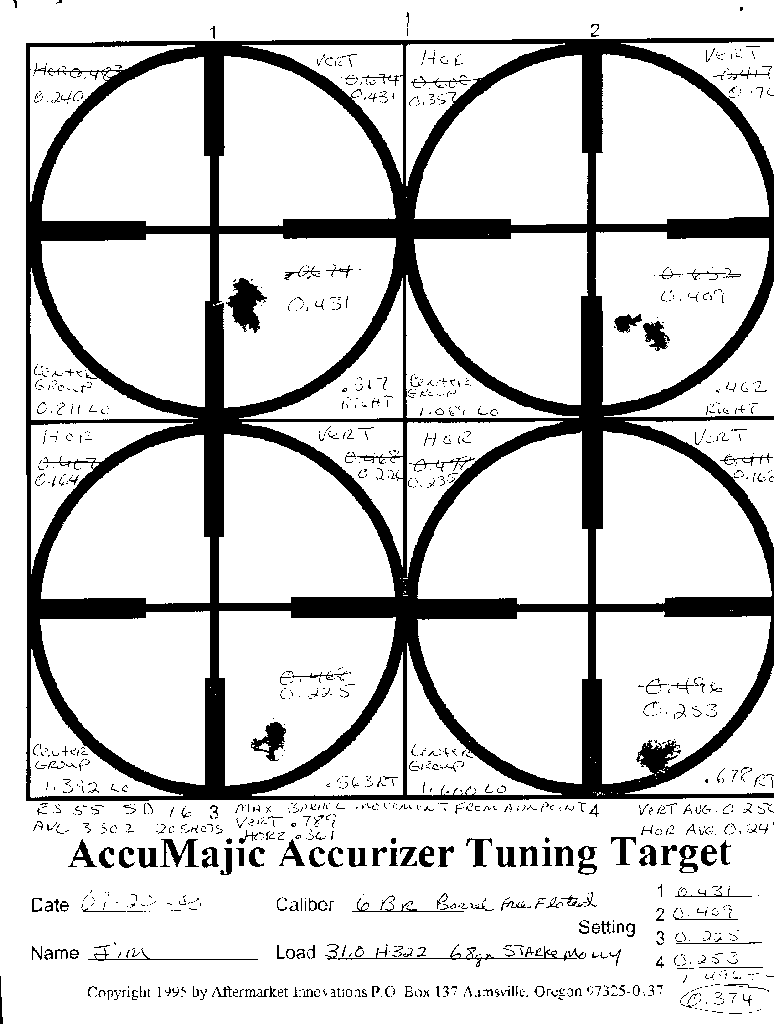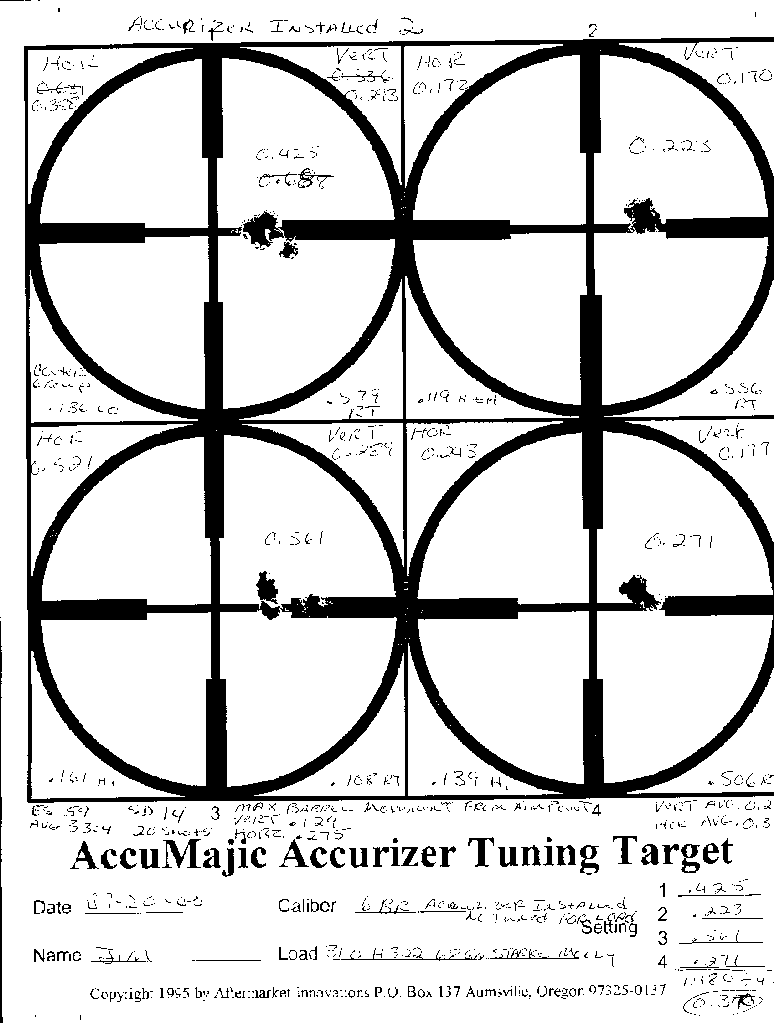
The targets on this page were shot on July 20, 2000 between 9 and 10 AM. It was sunny and the temperature was 65 degrees F. There was a light variable wind from the NNE to NE at approximately 2-8 MPH and I was shooting south. As with the targets on Page 2 no attempt to "dope the wind" was made, most shots were fired under the calmest conditions possible, and the same aimpoint (center of each target) was held for all tests. However, as a couple of groups on the targets indicate, I did get caught with changing conditions. The targets reflect the barrel movement at the rifle muzzle during each group and for the 20 shot sequence, both free floated as in target 1 and with a pressure point in the stock for target 2. The rifle was not cleaned since shooting the day before. Target 2 was shot immediately after target 1 and all groups were shot within a 7 minute time limit as would be the case during a match. The total barrel movement for each set of groups is quite obvious even to the casual observer.
Target 1
Barrel Free Floated

Free Floated Barrel Movement
|
1-1 |
1-2 |
1-3 |
1-4 |
| Average for all 4 Groups 3302 fps |
|
|
|
| ES 55 |
|
|
|
| SD 16 |
|
|
|
|
31.0 gr. H 322 |
31.0 H 322 |
31.0 gr. H 322 |
31.0 H 322 |
|
Group 0..431 |
0.409 |
0.225 |
0.253 |
| Vert. 0.431 | Vert. 0.174 | Vert. 0.226 | Vert. 0.168 |
| Hor. 0.240 | Hor. 0.357 | Hor. 0.164 | Hor. 0.235 |
|
|
Group Movement from 1-1 |
Group Movement from 1-1 |
Group Movement from 1-1 |
|
Vert. 0 |
Vert. -0.278 |
Vert. -0.581 |
Vert. -0.789 |
| Hor. 0 | Hor.Rt. 0.145 | Hor. Rt. 0.246 | Hor. Rt. 0.361 |
Target 2
Accurizer Installed But Not Tuned

Supported Barrel Movement
|
2-1 |
2-2 |
2-3 |
2-4 |
| Average for all 4 Groups 3304 fps |
|
|
|
| ES 59 |
|
|
|
| SD 14 |
|
|
|
|
31.0 gr. H 322 |
31.0 H 322 |
31.0 gr. H 322 |
31.0 H 322 |
|
Group 0.423 |
0.223 |
0.561 |
0.271 |
| Vert. 0.293 | Vert. 0.170 | Vert. 0.289 | Vert. 0.177 |
| Hor. 0.388 | Hor. 0.172 | Hor. 0.521 | Hor. 0.243 |
|
|
Group Movement from 2-1 |
Group Movement from 2-1 |
Group Movement from 2-1 |
|
Vert. 0 |
Vert. +0.119 |
Vert. +0.161 |
+0.139 |
| Hor. 0 | Hor. Lt. 0.023 | Hor. Rt. 0.129 | Hor. Lt. 0.073 |
Conclusion
The application of the Accurizer as a pressure point in the forend of the stock resulted in reducing unwanted vertical barrel deflection from temperature change by over 66% compared to the movement of an unsupported free floated barrel in these tests. This is essentially the same reduction in movement that was observed in the oven heat testing documented on Page 1.Hardly what we have been led to believe for all these years, is it?
I might suggest that anyone who is really interested in what actually happens to a free floated barrel as compared to a barrel, having a properly designed pressure point near the forend of the stock to support it, run the same test for yourself. (It is even much better when it will also tune your harmonics for the load you choose to use.) I would also appreciate hearing your results. I have done the same testing on two standard Remington 26" HV barrels and an Interarms Mauser and the results are similar, the difference is that the longer barrels have more vertical movement as they are thinner and longer and not of the quality of the Lilja barrels. However the two Remington rifles have been tuned to under 0.3 MOA with both handloads and Federal Gold Metal Match ammo and the Interarms 30-06 is tuned to under 0.5" with standard 165 grain hunting bullets.. If your rifles' barrel is not able to be easily removed, it might be hard to perform the oven heating tests, you can however perform the shooting test. Instead of using the oven simply fire multiple rounds (such as Varmint hunters quite often do) until it has heated too hot to hang on to comfortably. After doing so place a thermometer lead into the barrel, place the rifle stock on the bench (braced so it will not move) then place a dial indicator at the tip of the muzzle and let it cool. You will be able to determine the amount of vertical deflection of the muzzle from hot to cold. Or do the same shooting test as has been done on these pages and see the results, at the target, for your favorite hunting rifle, varmint rifle or bench gun.
What you choose to do with the information is of course up to you.
Copyrighted by Aftermarket Innovations Salem, Oregon 2000